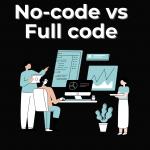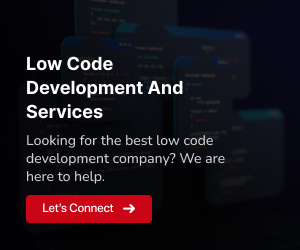The technological landscape is in constant flux, with innovations reshaping how we work and interact with the digital realm. In the realm of software development, the emergence of no-code low-code trends and platforms has revolutionized the way applications are created. As we step into 2023, a plethora of trends is set to redefine this space, ensuring efficiency, accessibility, and innovation take centre stage. In this comprehensive article, we delve into the top 10 trends shaping the no-code and low-code landscape in 2023, exploring their implications, potentials, and the exciting future they promise.
1. Hyperautomation Takes Center Stage
In the fast-paced digital landscape of 2023, businesses are increasingly turning to hyper-automation, a strategic approach that combines low-code development with advanced technologies like Artificial Intelligence (AI) and Machine Learning (ML). Unlike traditional automation, hyper-automation doesn’t merely automate repetitive tasks; it aims to automate complex business processes, decision-making, and interactions that require nuanced human-like intelligence.
a) Intelligent Process Automation (IPA)
Hyperautomation leverages Intelligent Process Automation (IPA) to handle end-to-end business processes. Low-code platforms, equipped with IPA capabilities, can automate intricate workflows across various departments. These platforms utilize AI algorithms to analyze data, recognize patterns, and make decisions, replicating human-like cognitive abilities.
b) Advanced Data Analysis
Hyperautomation integrates AI-driven data analysis tools into low-code platforms. These tools can process vast datasets, identify trends, and generate actionable insights. For businesses, this means the ability to make data-driven decisions without investing extensive time in data analysis.
2. Evolution of No-Code Development for Citizen Developers
In 2023, the landscape of software development is undergoing a significant shift, empowering individuals without extensive technical backgrounds, known as citizen developers, to create sophisticated applications. This transformation is made possible by the evolution of no-code development platforms, which are becoming increasingly intuitive and user-friendly.
a) User-friendly interface and Intuitive Design
Modern no-code platforms prioritize user experience. They feature drag-and-drop interfaces, pre-built templates, and visual development tools that require little to no coding knowledge. Citizen developers can design applications by assembling components, widgets, and logic elements, all through a seamless and intuitive interface.
b) Empowering Non-Technical Users
No-code platforms empower individuals with domain expertise, such as marketing professionals, business analysts, or HR specialists, to actively participate in the application development process. These platforms provide a wide array of pre-built functionalities, ranging from database integration to form creation and workflow automation. Citizen developers can leverage these features to address department-specific challenges, enhance productivity, and streamline processes without delving into the complexities of coding.
3. AI-Powered Automation and Intelligent Workflows
In the ever-evolving landscape of technology, the integration of artificial intelligence (AI) into no-code and low-code platforms stands out as a transformative trend in 2023. This integration is ushering in an era of intelligent automation and workflows, fundamentally changing the way businesses operate and optimize their processes.
a) Data-driven Decision Making
AI-powered no-code platforms leverage advanced algorithms to analyze vast amounts of data quickly and accurately. These platforms can process diverse data sets, ranging from customer interactions to market trends, extracting valuable insights that were previously buried in the data deluge. Citizen developers can harness these insights to make informed decisions, enhancing strategic planning, product development, and customer engagement.
b) Intelligent Process Automation
Traditional automation focuses on rule-based tasks, automating repetitive actions according to predefined criteria. AI-driven automation, on the other hand, is intelligent and adaptive. No-code platforms integrated with AI can learn from patterns in data and user behaviour, enabling the automation of complex, context-aware processes. For instance, in customer service, AI can analyze the sentiment of customer queries and route them to the most appropriate department, ensuring efficient and personalized responses.
4. Integration of IoT Devices and Low-Code Platforms
The integration of Internet of Things (IoT) devices with low-code platforms represents a pivotal trend in the technology landscape of 2023. IoT devices, ranging from smart appliances to industrial sensors, are generating vast volumes of real-time data. Leveraging low-code platforms, businesses can seamlessly integrate, process, and analyze this data, unlocking transformative possibilities across various sectors.
a) Real-Time Data Analysis
IoT devices continuously collect and transmit data, offering valuable insights into diverse environments. Low-code platforms equipped with IoT integration capabilities enable businesses to harness this real-time data for immediate analysis. For example, in manufacturing, IoT sensors on machinery can monitor production parameters, detecting anomalies or inefficiencies in real-time.
b) Predictive Maintenance and Optimization
One of the significant advantages of IoT integration with low-code platforms is predictive maintenance. By analyzing data from sensors embedded in machinery and equipment, businesses can predict when maintenance is required before a breakdown occurs. This proactive approach minimizes downtime, reduces maintenance costs, and extends the lifespan of assets.
5. AI and Machine Learning Integration for Intelligent Automation
In 2023, the integration of Artificial Intelligence (AI) and Machine Learning (ML) with low-code platforms is at the forefront of technological innovation. This powerful synergy empowers businesses to automate complex processes, gain actionable insights from data, enhance decision-making, and deliver highly personalized user experiences.
a) Advanced Automation Capabilities
Low-code platforms, when infused with AI and ML capabilities, can automate intricate workflows that involve decision-making based on vast datasets. For instance, in financial services, AI-driven algorithms can assess transaction patterns, detect anomalies, and flag potentially fraudulent activities in real-time.
b) Predictive Analytics for Data-Driven Decisions
AI and ML algorithms integrated with no-code low-code trends and platforms excel at predictive analytics. These algorithms analyze historical data patterns, identify trends, and forecast future outcomes. For businesses, this translates into the ability to make data-driven decisions. In e-commerce, predictive analytics can analyze customer behaviour data to forecast demand for specific products.
6. Enhanced Security Measures and Compliance
In 2023, the integration of enhanced security measures and compliance features is crucial within no-code/low-code platforms. As businesses increasingly rely on these platforms to develop applications, ensuring robust security and compliance becomes paramount. Here’s a detailed look at how this point is shaping the landscape:
a) Data Encryption and Secure Access Control:
Modern no-code/low-code platforms employ advanced encryption techniques to safeguard data both at rest and in transit. They enable businesses to define strict access controls, ensuring that only authorized personnel can view or modify sensitive information. Role-based access control (RBAC) and multi-factor authentication (MFA) are integral features, allowing organizations to customize user permissions and add an additional layer of security.
b) Compliance with Regulatory Standards:
Industries such as finance, healthcare, and e-commerce operate under strict regulatory frameworks (such as GDPR, HIPAA, or PCI DSS). No-code/low-code platforms are designed to comply with these regulations. They offer functionalities like data anonymization, audit trails, and automatic compliance checks.
7. Advanced Integration Capabilities and Extensibility
In 2023, no-code/low-code platforms have evolved to offer advanced integration capabilities and extensibility features, making them indispensable tools for businesses seeking seamless connectivity and customizability. Here’s a detailed look at how this point is transforming the landscape:
a) Comprehensive API Support:
Modern no-code low-code trends and platforms come with extensive support for APIs (Application Programming Interfaces). They allow businesses to connect their applications with a wide array of services, databases, and third-party applications. These platforms often provide pre-built connectors for popular APIs, enabling effortless integration. Moreover, they empower users to create custom APIs, facilitating integration with proprietary systems and services tailored to specific business needs.
b) Data Synchronization and Transformation:
No-code/low-code platforms feature robust data integration tools that facilitate seamless synchronization between various data sources. They offer data transformation capabilities, allowing businesses to manipulate and structure data as needed. Whether it’s aggregating data from different databases or transforming data formats, these platforms provide intuitive drag-and-drop interfaces for users to design data workflows without the need for complex coding.
8. Enhanced Collaboration and Team Productivity
Effective collaboration and streamlined communication are paramount in any business environment. No-code and low-code platforms excel in enhancing collaboration and team productivity, fostering seamless interaction among team members, departments, and stakeholders. Here’s a detailed exploration of this pivotal point:
a) Centralized Collaboration Hub:
No-code and low-code platforms often feature centralized collaboration hubs where team members can collaborate on projects, share ideas, and provide feedback. These hubs serve as digital workspaces where employees can collaborate in real time, eliminating the barriers of physical proximity. Team members can access project-related information, updates, and discussions from anywhere, ensuring that everyone stays on the same page.
b) Visual Workflow Design:
One of the core advantages of no-code low-code trends and platforms is their visual development interface. Team members, regardless of their technical expertise, can design workflows and applications using intuitive drag-and-drop interfaces. This visual approach simplifies the creation of complex processes, allowing non-technical users to contribute actively to the development process. Collaborators can provide input on the application’s design, logic, and user experience, fostering a collaborative environment where diverse perspectives are valued.
9. Artificial Intelligence (AI) and Machine Learning (ML) Integrations
In the rapidly evolving technological landscape, the integration of Artificial Intelligence (AI) and Machine Learning (ML) capabilities has become a game-changing trend in no-code and low-code platforms. This integration empowers businesses to leverage advanced algorithms and predictive analytics without requiring an in-depth understanding of complex programming languages or algorithms. Here’s a deeper dive into this transformative aspect:
a) Predictive Analytics and Data Insights:
No-code and low-code platforms equipped with AI and ML integrations enable businesses to harness the power of predictive analytics. These platforms can analyze vast datasets, identify patterns, and predict future trends, allowing organizations to make data-driven decisions. By providing actionable insights derived from historical and real-time data, businesses can optimize their strategies, anticipate market demands, and enhance their overall competitiveness.
b) Automated Decision-Making:
AI and ML integrations enable the automation of decision-making processes within no-code low-code trends. Businesses can define rules and criteria, and integrated AI algorithms can automatically make decisions based on real-time data inputs. This automation streamlines workflows reduces manual intervention and ensures consistency in decision-making. Whether it’s approving transactions, classifying customer inquiries, or prioritizing tasks, automated decision-making enhances operational efficiency and minimizes errors.
10. Integration of Advanced Data Visualization Tools
The integration of advanced data visualization tools is a crucial trend within no-code low-code trends and platforms, enabling businesses to transform raw data into meaningful insights. Here’s an in-depth exploration of this significant aspect:
a) Interactive Dashboards and Reports:
No-code and low-code platforms with integrated data visualization tools offer interactive dashboards and reports. These dashboards provide visually appealing representations of complex data sets, allowing users to explore data, identify trends, and gain valuable insights at a glance.
b) Real-Time Data Monitoring:
Modern businesses operate in a fast-paced environment where real-time insights are invaluable. Advanced data visualization tools integrated into no-code and low-code platforms facilitate real-time data monitoring. Businesses can track key metrics, monitor live data streams, and receive instant updates on various performance indicators.
Wrapping up!
In the rapidly evolving realm of technology, the fusion of no-code low-code platforms with innovative trends in 2023 heralds an era of boundless possibilities. GeekyAnts caters to diverse industries, providing tailored solutions that align with specific requirements. These platforms have become the catalysts for democratizing software development, putting the power of creation into the hands of individuals and businesses alike. By embracing the trends highlighted in this article, developers and organizations are not merely adapting to change; they are pioneering it. The essence of these trends lies in empowerment. Hyperautomation streamlines processes, AI-driven development enhances intelligence, and no-code mobile app solutions make creativity accessible.



















